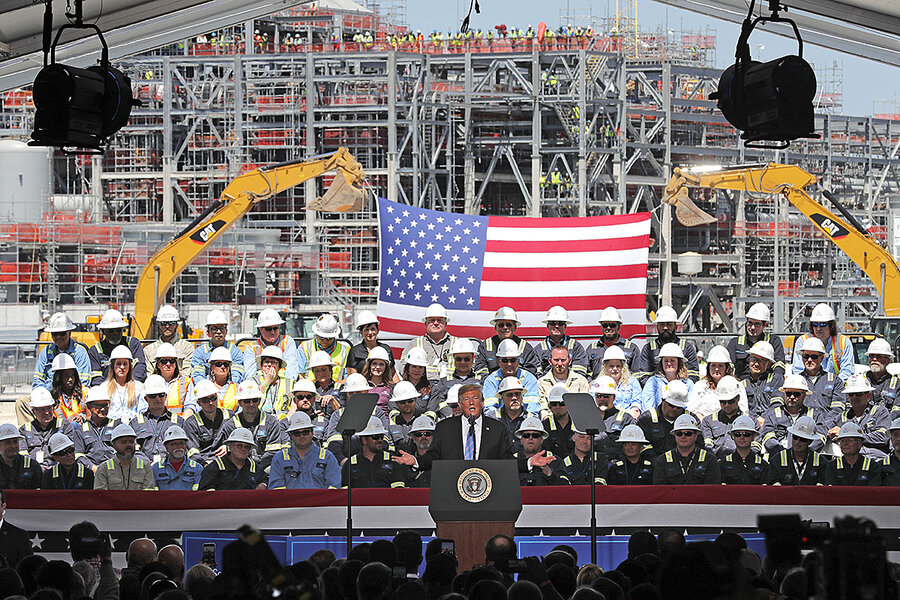Both parties agree infrastructure needs fixing. So why hasn’t it happened?
Loading...
| Washington
When President Donald Trump took office some two and a half years ago, two-thirds of Americans regarded improving the nation’s infrastructure as “very important.” Last December, again, Americans ranked infrastructure as one of the top priorities for the incoming Congress.
Yet despite another infrastructure meeting today between Mr. Trump and Democratic leaders, there’s little evidence of a deal on the horizon. Funding remains a sticking point. An analysis by the American Society of Civil Engineers showed that it would cost nearly $4.6 trillion to repair the countries bridges, dams, and sewage systems.
Why We Wrote This
It can be hard for Congress to pass legislation when there are sharp partisan differences. But on infrastructure, there’s actually plenty of agreement. Progress has stalled over questions of funding – and political positioning.
Infrastructure is also not a big topic on the campaign trail. Aside from trillion-dollar proposals by Minnesota Sen. Amy Klobuchar and former Maryland Rep. John Delaney, it has been largely absent from the 2020 conversation.
Why would an issue with so much bipartisan agreement be garnering so little traction or attention? For precisely that reason: because it doesn’t allow candidates to draw a clear contrast. “The basic position is just let’s fix it,” says Laura Stoker, a political science professor at the University of California, Berkeley. “This is a really hard issue to differentiate [between] the parties or to differentiate you from someone else.”
In the wee hours of the morning on Nov. 9, 2016, Donald Trump took to the podium for the first time as president-elect and promised to “begin the urgent task of rebuilding our nation.”
“We are going to fix our inner cities and rebuild our highways, bridges, tunnels, airports, schools, hospitals,” the former real estate mogul vowed. “We’re going to rebuild our infrastructure – which will become, by the way, second to none. And we will put millions of our people to work as we rebuild it.”
It was Mr. Trump’s most popular campaign promise, with two-thirds of Americans saying they saw more infrastructure spending as “very important.”
Why We Wrote This
It can be hard for Congress to pass legislation when there are sharp partisan differences. But on infrastructure, there’s actually plenty of agreement. Progress has stalled over questions of funding – and political positioning.
Two and a half years later, the promise remains unfulfilled. Despite yet another meeting today between the president and congressional leaders to discuss the matter, there’s little evidence of any kind of deal on the horizon.
Mr. Trump told reporters after today’s meeting that there could be no progress on infrastructure until Democrats stopped their investigations of him, saying “You can go down the investigation track or you can go down the investment track.” Democrats called that a convenient excuse. “We are interested in doing infrastructure,” Senate Minority Leader Chuck Schumer said. “It’s clear the president isn’t.”
Yet Americans’ priorities haven’t changed. A Politico poll late last year showed that Americans thought improving the country’s infrastructure was the third most important issue for the incoming Congress – and that was before floodwaters drowned most of the heartland.
On its face, infrastructure seems like prime stump speech material for the Democrats running in the 2020 presidential race: serious needs, bipartisan support, and an opportunity to highlight Mr. Trump’s failure to deliver. And yet, aside from trillion-dollar proposals by Minnesota Sen. Amy Klobuchar and former Maryland Rep. John Delaney, infrastructure has been largely absent from the campaign conversation. Even the media is ignoring it: Politico’s overview of the “big 2020 issues” doesn’t include infrastructure.
Why would an issue with so much bipartisan agreement be garnering so little traction or attention? For precisely that reason.
“With infrastructure, the basic position is just let’s fix it; let’s improve it. Everybody agrees with that objective,” says Laura Stoker, a political science professor at the University of California, Berkeley. As a candidate, “you want to do something that gives you an edge over your competitors. And this is a really hard issue to differentiate [between] the parties or to differentiate you from someone else.”
If distinction is more useful in politics, then the broad consensus around infrastructure may paradoxically be proving unhelpful. Ms. Stoker calls it a “loser” issue, especially with 23 Democrats vying for the same slice of the electoral pie.
Unsafe water, crumbling bridges
Americans’ concern about the state of the nation’s infrastructure is warranted. Unsafe drinking water threatens 21 million people annually, traffic congestion stole nearly 100 hours from the average American last year, and floods buckled hundreds of miles of levees across the heartland this spring and obliterated millions of acres of crops.
Nearly 40% of bridges are 50 years old or more, and 9% of them are structurally deficient, according to the 2017 infrastructure “report card” from the American Society of Civil Engineers (ASCE). Not to mention a looming “silver tsunami” as workers in many infrastructure industries like construction and aviation near retirement.
Yet getting any legislation passed to address these challenges appears all but impossible. Publicly, both parties support an infrastructure bill. House Speaker Nancy Pelosi and Senator Schumer have been trying for weeks to work out a $2 trillion deal with Mr. Trump. However, even as negotiations were going on, acting White House Chief of Staff Mick Mulvaney cast doubt on the bill’s prospects.
Funding remains the sticking point. An ASCE analysis showed that it would cost nearly $4.6 trillion to repair’s the countries bridges, dams, and sewage systems.
“Infrastructure is a good talking point. But then to actually do something about it is extraordinarily difficult, not only politically, but logistically and financially,” says Joseph Kane, a Brookings Institution senior policy analyst.
The bills also languish because of the infighting between the nearly 20 industries that fall under the broad umbrella of infrastructure.
“There are such vast needs across multiple modes, just within the machinations of Congress,” says Jake Varn, a policy analyst at the Bipartisan Policy Center. “It’s a very complicated process to cobble together a bill that addresses highways and water systems and broadband and transit.”
‘Fix the Damn Roads’
While the presidential hopefuls may be largely ignoring infrastructure, some down-ballot candidates have recently demonstrated how to use it effectively on the campaign trail. Democrat Gretchen Whitmer won the 2018 Michigan gubernatorial race largely on her platform to “Fix the Damn Roads.” A promise to resolve traffic issues propelled Democrat Danica Roem to the Virginia House of Representatives in 2017.
Voters respond best when candidates emphasize how infrastructure impacts their daily lives, as with commutes or drinking water. But its wide reach expands its relevance, says Mr. Varn.
“Infrastructure is an intersectional issue: It impacts education; it impacts housing; it impacts climate,” he says. “I think a lot of candidates are picking one big plank issue that they’re hoping to get voters to focus on, and they’re interweaving their infrastructure proposals through those lenses.” Indeed, many of the more ambitious plans to address climate change – such as the one put forward by Washington Gov. Jay Inslee – do tackle infrastructure as part of that agenda.
Ultimately, what becomes politically relevant depends on who takes up a given issue and how much bandwidth voters have to process the message, says Ms. Stoker.
“You have to have clear policy proposals, you have to have clear points of delineation between the parties, and all of that has to take time to develop,” she says. “And it’s competing with everything else for people’s attention.”








